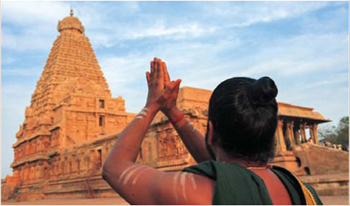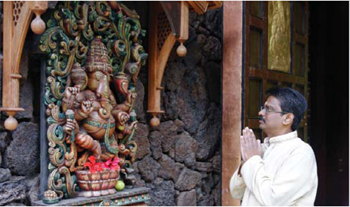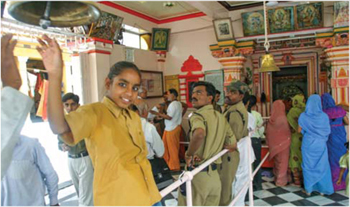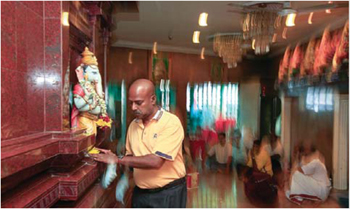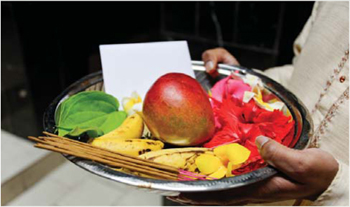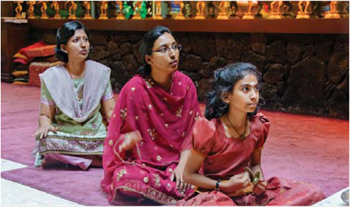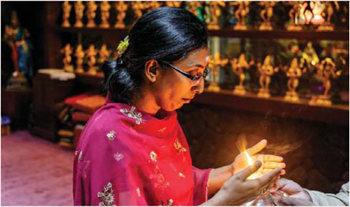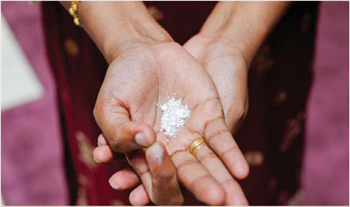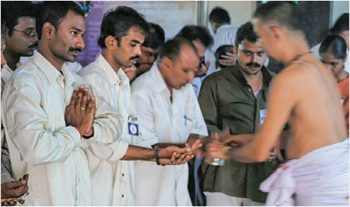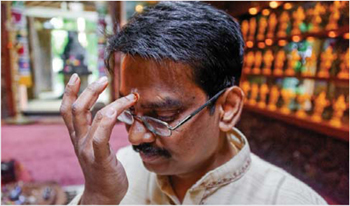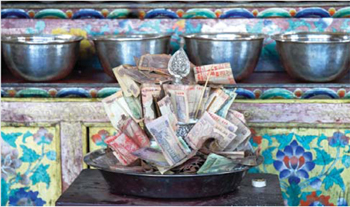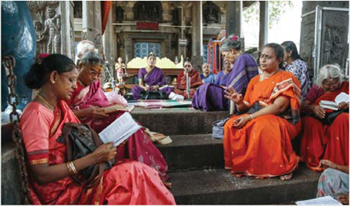18 Steps for Visiting a Hindu Temple
 ou will want to look and feel your best when you go to the temple, God’s home. Prepare yourself by bathing and putting on clean clothing. Traditional dress is best—saris or punjabis for ladies, long dresses for girls, and kurta and dhoti or pants for men and boys. But any nice, modest clothing suitable for sitting on the floor is acceptable. In anticipation of your visit, prepare your mind by thinking about God. Keep focused on your spiritual purpose during travel time, be it a few minute’s drive or a long pilgrimage. If traveling with family or friends, direct discussions to spiritual matters and away from worldliness.§
ou will want to look and feel your best when you go to the temple, God’s home. Prepare yourself by bathing and putting on clean clothing. Traditional dress is best—saris or punjabis for ladies, long dresses for girls, and kurta and dhoti or pants for men and boys. But any nice, modest clothing suitable for sitting on the floor is acceptable. In anticipation of your visit, prepare your mind by thinking about God. Keep focused on your spiritual purpose during travel time, be it a few minute’s drive or a long pilgrimage. If traveling with family or friends, direct discussions to spiritual matters and away from worldliness.§
Bring an offering: such as fruits and flowers or flower garlands. On arrival, it is traditional to circumambulate the temple where possible. Inside, greet the Deities at their shrines, hands pressed together in namaskara, starting with Lord Ganesha. You may prostrate and present your offerings. Inwardly feel God’s uplifting presence, called sannidhya. §
The primary focus of Hindu temples is the worship ritual called puja (see p. 39). Puja is a ceremony in which the ringing of bells, passing of flames, presenting of offerings and chanting invoke the blessings of God and Gods. During the puja, focus on the acts of worship, rather than letting your mind wander. Over time, devotees strive to learn the inner meaning of what the priest is doing and mentally follow along. §
Ardent worship takes many forms in a temple. You can be immersed in the joys of devotion, in prayerful communion, seeking consolation for a loss, singing hymns, chanting mantras or celebrating a rite of passage. Meditation is appropriate, especially after the puja, and emotion is not out of place. God will receive your devotion, however you offer it.§
Dancing with Siva summarizes: “With offerings in hand, leaving our shoes outside, we enter through the gopura, or temple tower, wash hands, feet and mouth, and seek blessings at Lord Ganesha’s shrine. Next we follow the outer prakara, or hallway, clockwise around the mahamandapa, central chambers. Inside we leave our worldly thoughts at the balipitha, or offering place, then prostrate before the dhvajastambha, temple flagpole, and worship Nandi the sacred bull [or Garuda, Mushika, etc.]. Next we circumambulate the central sanctum, garbhagriha, usually three times, returning to its entrance for worship. During puja, we stand with hands folded or in anjali mudra, though according to temple custom, it may be proper to sit quietly or sing devotional hymns. After the arati, or waving of the camphor light before the Deity, we prostrate (ashtanga pranama for men, and panchanga pranama for women) and rise to receive the prasada, accepting them in the right hand. We walk around the garbhagriha one final time before taking our leave.” §
YOU ARE THERE§
WORSHIPING & ATTENDING PUJA§
RECEIVING THE PUJA SACRAMENTS§
AFTER THE CEREMONY§
About Sacraments
 t the end of the puja, the priest passes out to the attending devotees various substances that were offered to the Deity. By partaking of these offerings, called prasada, one absorbs the blessings into one’s being. Observe the way experienced temple-goers receive these sacraments to properly learn the nuanced customs.§
t the end of the puja, the priest passes out to the attending devotees various substances that were offered to the Deity. By partaking of these offerings, called prasada, one absorbs the blessings into one’s being. Observe the way experienced temple-goers receive these sacraments to properly learn the nuanced customs.§
First, the sacramental lamp which has just been offered at the high point of the puja is passed among the devotees. The devas can see and bless you through this flame as it lights up your face. Sometimes you, too, can glimpse into their world. When the priest comes to you with the lamp, reach out and pass both hands devoutly over the flame. Then bring your hands back, turn your palms toward your face and touch your eyes with your fingertips to receive the Deity’s blessings. (In some temples, the devotees take turns passing the arati flame in front of the murtis while singing “Jai Jagadish Hare....”)§
At a shrine to Lord Vishnu, the priest may bring out the Deity’s silver or gold crown and lightly touch it to the head of each devotee. This represents God’s feet being placed on your head. A sacrament offered at Siva shrines is holy ash, vibhuti, made by burning dried cow dung with ghee, flowers, yogurt and other ingredients. It symbolizes the purity we attain by burning the bonds of ego, karma and maya to reveal the soul’s natural goodness. It is applied on the forehead, generally three broad stripes for men, and one short stroke for ladies. A spoonful of blessed water that was offered to the Deity, or milk with which the Deity was bathed during the puja, may be offered for you to drink.§
Sandalwood paste, valued for its fragrance, is often next. A small dab is placed in your hand by the priest, which you transfer to your left palm with a wiping motion. Dip your right ring finger into the paste and apply it with a small circular motion between the eyebrows, or in your chosen sectarian mark. A red powder called kumkum is then given. The priest will place a small pinch in your right hand or invite you to take some from the container he holds before you. Apply the kumkum on top of the sandalwood, creating a dot, or bindi, which represents the third eye of spiritual seeing. Vaishnava Hindus traditionally apply a V-shaped tilaka on the forehead representing the feet of the Lord.§
Flowers may also be distributed by the priest, as well as cooked food. Many devotees wrap portions of their prasada to share with loved ones or place on their home altar. §
 Did You Know?
Did You Know?
All giving and receiving in the Hindu tradition is done only with the right hand or with both hands.§
